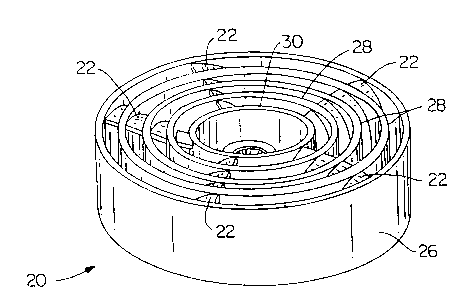Some of the information on this Web page has been provided by external sources. The Government of Canada is not responsible for the accuracy, reliability or currency of the information supplied by external sources. Users wishing to rely upon this information should consult directly with the source of the information. Content provided by external sources is not subject to official languages, privacy and accessibility requirements.
Any discrepancies in the text and image of the Claims and Abstract are due to differing posting times. Text of the Claims and Abstract are posted:
| (12) Patent Application: | (11) CA 2354807 |
|---|---|
| (54) English Title: | MOTOR COOLING FAN BLADE ASSEMBLY WITH FINGER GUARD |
| (54) French Title: | LAME DE VENTILATEUR DE REFROIDISSEMENT A MOTEUR AVEC PROTEGE-DOIGTS |
| Status: | Deemed Abandoned and Beyond the Period of Reinstatement - Pending Response to Notice of Disregarded Communication |
| (51) International Patent Classification (IPC): |
|
|---|---|
| (72) Inventors : |
|
| (73) Owners : |
|
| (71) Applicants : |
|
| (74) Agent: | NORTON ROSE FULBRIGHT CANADA LLP/S.E.N.C.R.L., S.R.L. |
| (74) Associate agent: | |
| (45) Issued: | |
| (22) Filed Date: | 2001-08-07 |
| (41) Open to Public Inspection: | 2002-02-28 |
| Examination requested: | 2001-08-07 |
| Availability of licence: | N/A |
| Dedicated to the Public: | N/A |
| (25) Language of filing: | English |
| Patent Cooperation Treaty (PCT): | No |
|---|
| (30) Application Priority Data: | ||||||
|---|---|---|---|---|---|---|
|
A prop fan blade assembly for a draft inducer motor cooling fan used in a high
efficiency furnace includes rings concentric with and attached to an outer
blade guard.
Cooling air is drawn through the concentric rings by the fan and blown onto
the
motor. The rings function as a finger guard while producing a confined airflow
pattern which does not interfere with burner operation.
Note: Claims are shown in the official language in which they were submitted.
Note: Descriptions are shown in the official language in which they were submitted.

2024-08-01:As part of the Next Generation Patents (NGP) transition, the Canadian Patents Database (CPD) now contains a more detailed Event History, which replicates the Event Log of our new back-office solution.
Please note that "Inactive:" events refers to events no longer in use in our new back-office solution.
For a clearer understanding of the status of the application/patent presented on this page, the site Disclaimer , as well as the definitions for Patent , Event History , Maintenance Fee and Payment History should be consulted.
| Description | Date |
|---|---|
| Application Not Reinstated by Deadline | 2007-08-07 |
| Time Limit for Reversal Expired | 2007-08-07 |
| Deemed Abandoned - Failure to Respond to Maintenance Fee Notice | 2006-08-07 |
| Amendment Received - Voluntary Amendment | 2006-07-19 |
| Inactive: IPC from MCD | 2006-03-12 |
| Inactive: IPC from MCD | 2006-03-12 |
| Inactive: IPC from MCD | 2006-03-12 |
| Inactive: IPC from MCD | 2006-03-12 |
| Inactive: S.30(2) Rules - Examiner requisition | 2006-01-30 |
| Amendment Received - Voluntary Amendment | 2005-06-29 |
| Inactive: S.29 Rules - Examiner requisition | 2005-01-06 |
| Inactive: S.30(2) Rules - Examiner requisition | 2005-01-06 |
| Amendment Received - Voluntary Amendment | 2004-10-18 |
| Inactive: S.30(2) Rules - Examiner requisition | 2004-04-16 |
| Inactive: S.29 Rules - Examiner requisition | 2004-04-16 |
| Letter Sent | 2003-08-25 |
| Revocation of Agent Requirements Determined Compliant | 2003-03-25 |
| Inactive: Office letter | 2003-03-25 |
| Inactive: Office letter | 2003-03-25 |
| Appointment of Agent Requirements Determined Compliant | 2003-03-25 |
| Appointment of Agent Request | 2003-03-14 |
| Revocation of Agent Request | 2003-03-14 |
| Application Published (Open to Public Inspection) | 2002-02-28 |
| Inactive: Cover page published | 2002-02-27 |
| Inactive: First IPC assigned | 2001-10-23 |
| Inactive: Filing certificate - RFE (English) | 2001-08-28 |
| Filing Requirements Determined Compliant | 2001-08-28 |
| Letter Sent | 2001-08-28 |
| Application Received - Regular National | 2001-08-28 |
| Request for Examination Requirements Determined Compliant | 2001-08-07 |
| All Requirements for Examination Determined Compliant | 2001-08-07 |
| Abandonment Date | Reason | Reinstatement Date |
|---|---|---|
| 2006-08-07 |
The last payment was received on 2005-08-08
Note : If the full payment has not been received on or before the date indicated, a further fee may be required which may be one of the following
Please refer to the CIPO Patent Fees web page to see all current fee amounts.
| Fee Type | Anniversary Year | Due Date | Paid Date |
|---|---|---|---|
| Request for examination - standard | 2001-08-07 | ||
| Registration of a document | 2001-08-07 | ||
| Application fee - standard | 2001-08-07 | ||
| MF (application, 3rd anniv.) - standard | 03 | 2004-08-09 | 2003-07-30 |
| MF (application, 2nd anniv.) - standard | 02 | 2003-08-07 | 2003-08-06 |
| MF (application, 4th anniv.) - standard | 04 | 2005-08-08 | 2005-08-08 |
Note: Records showing the ownership history in alphabetical order.
| Current Owners on Record |
|---|
| CARRIER CORPORATION |
| Past Owners on Record |
|---|
| DUANE D. GARLOCH |
| TIMOTHY J. WATERMAN |